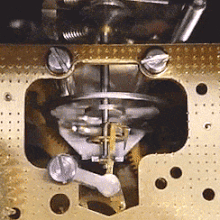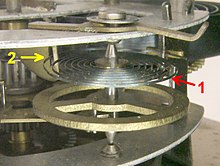
Back عجلة اتزان Arabic Volant regulador Catalan Setrvačka Czech Unruh (Uhr) German Balanciero (horloĝo) Esperanto Volante regulador Spanish رقاصک Persian Balancier (horlogerie) French Nemirnica Croatian Bilanciere (orologeria) Italian



A balance wheel, or balance, is the timekeeping device used in mechanical watches and small clocks, analogous to the pendulum in a pendulum clock. It is a weighted wheel that rotates back and forth, being returned toward its center position by a spiral torsion spring, known as the balance spring or hairspring. It is driven by the escapement, which transforms the rotating motion of the watch gear train into impulses delivered to the balance wheel. Each swing of the wheel (called a "tick" or "beat") allows the gear train to advance a set amount, moving the hands forward. The balance wheel and hairspring together form a harmonic oscillator, which due to resonance oscillates preferentially at a certain rate, its resonant frequency or "beat", and resists oscillating at other rates. The combination of the mass of the balance wheel and the elasticity of the spring keep the time between each oscillation or "tick" very constant, accounting for its nearly universal use as the timekeeper in mechanical watches to the present. From its invention in the 14th century until tuning fork and quartz movements became available in the 1960s, virtually every portable timekeeping device used some form of balance wheel.
© MMXXIII Rich X Search. We shall prevail. All rights reserved. Rich X Search